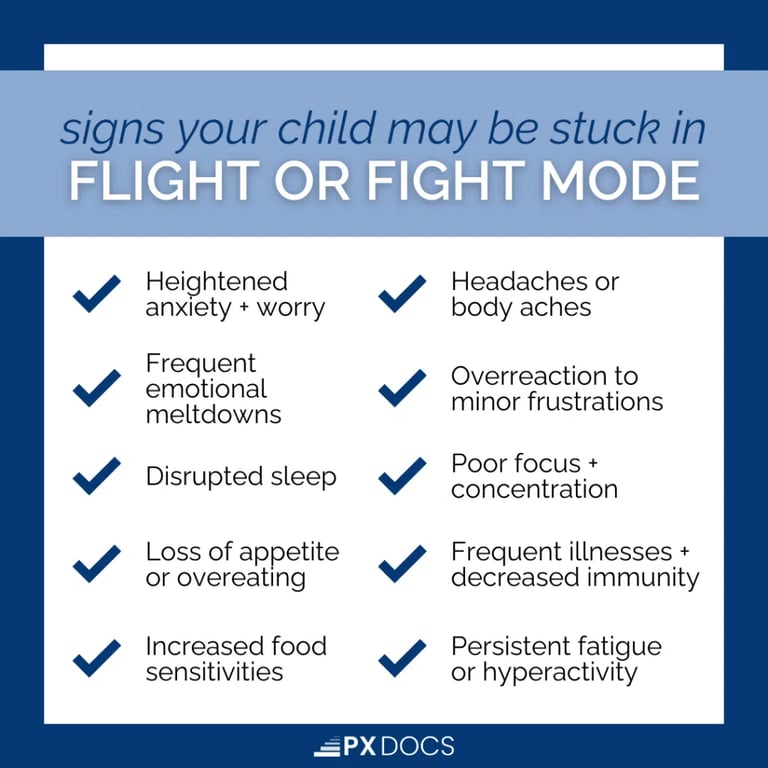Fight or Flight Nervous System Stuck On
This article explores how a child’s nervous system can become stuck in fight or flight mode, leading to chronic health challenges, and how neurologically-focused chiropractic care can help restore balance, calm, and healing.


When a Child’s Nervous System is Stuck in Fight or Flight
Is Your Child Constantly Struggling to Calm Down?
Does your child seem anxious no matter what you try? Are they dealing with poor sleep, frequent meltdowns, recurring illness, or chronic inflammation even though you're doing everything you can to support their health? These ongoing challenges often point to a nervous system that’s stuck in overdrive.
More than 77% of today’s kids face chronic health conditions, many of them tied to neurological and emotional dysregulation. At the core of it, research increasingly shows a common culprit hiding in plain sight: a nervous system stuck in "fight or flight" mode.
What Happens When Fight or Flight Won’t Turn Off?
When the sympathetic nervous system—your child’s built-in stress response—stays stuck in the "on" position, it floods the body with stress hormones and keeps the body in survival mode. Vital systems like digestion, immunity, and brain development take a backseat. The natural calming system, known as the parasympathetic or "rest and digest" response, gets pushed aside.
This creates a destructive cycle that can affect nearly every aspect of your child’s health and development. We call it The Perfect Storm—a buildup of early stressors (starting as early as pregnancy) that overload and lock the nervous system into a heightened, reactive state.
But here’s the good news: with the right support, that storm can be calmed, and your child’s nervous system can be reset and regulated again.
Meet the Vagus Nerve: The Body’s “Calm Down” Button
The vagus nerve is the command center for the parasympathetic nervous system. It controls functions like digestion, breathing, heart rate, immunity, and even speech and emotional regulation. When the vagus nerve isn’t working well—what we call poor vagal tone—kids stay stuck in stress mode. This condition, known as dysautonomia, leads to a wide range of chronic health struggles.
Understanding the Fight or Flight System
The nervous system is meant to move between active (sympathetic) and restful (parasympathetic) states. When danger arises, "fight or flight" kicks in to protect us. But once the danger is gone, the system should shift back to calm and recovery.
When that shift doesn’t happen—when stress hormones stay elevated long-term—it interferes with regulation and healing. For children, this leads to things like anxiety, sensory overload, poor focus, digestive issues, and frequent illness.
Signs Your Child May Be Stuck in Fight or Flight
A child stuck in stress mode may show:
Constant anxiety or panic
Big emotional outbursts or meltdowns
Nightmares and poor sleep
Changes in appetite (loss or overeating)
Sensitivities to foods or allergies
Headaches or chronic body tension
Trouble focusing or sitting still
Getting sick often
Fatigue or hyperactivity
These are signs that multiple body systems are under pressure—driven by an overactive stress response and a suppressed calming system.
The Deeper Impact of a Dysregulated Nervous System
Emotional Challenges:
Kids may constantly worry, have panic attacks, experience nightmares, or feel irritable and overwhelmed. Their ability to self-regulate emotions diminishes.
Behavioral and Cognitive Issues:
Chronic stress disrupts brain development, often showing up as ADHD, obsessive thoughts, defiance, impulsivity, or memory and focus issues.
Physical Symptoms:
Children may develop chronic headaches, digestive problems, fatigue, and lowered immunity, often battling repeated infections or inflammatory conditions.
Developmental Delays:
When the body is stuck in survival mode, growth takes a backseat. This can lead to speech delays, poor motor coordination, sleep disruption, and challenges in weight gain or feeding.
Why Traditional Approaches Fall Short
Most medical professionals focus on isolated symptoms or systems—gastrointestinal issues, sleep, behavior, etc.—without recognizing the nervous system’s role in tying them all together. Neurologically-Focused Pediatric Chiropractors, however, are trained to identify the underlying imbalance: a nervous system that’s stuck in fight or flight.
The Root Cause Deserves a Root Solution
The true breakthrough comes from targeting that underlying stress and restoring balance in the nervous system. With precise, neurologically-focused chiropractic care, we can release the stress that's keeping your child stuck and activate the vagus nerve to help the body rest, heal, and regulate again.
What Causes the System to Get Stuck?
Stress early in life—especially during prenatal development or birth—can have lasting effects. C-sections, forceps, and birth trauma may impair the vagus nerve before a child ever takes their first breath. Over time, this “gas pedal stuck on” state drains the adrenals, disrupts sleep and digestion, and leaves the calming system offline.
Getting Out of Fight or Flight: What Actually Works?
While breathing exercises, yoga, sleep routines, and supplements can help regulate stress, they often aren’t enough for a child with a deeply dysregulated nervous system. That’s why many parents feel like they’ve "tried everything" without success.
The real starting point for many of these children is Neurologically-Focused Chiropractic Care. By using targeted adjustments to release stress on the nervous system and stimulate the vagus nerve, we can help turn off the chronic fight or flight response and rebuild regulation from the inside out.
A Personalized Roadmap to Healing
We’ve found that healing unfolds in three key phases:
Release (Months 1–2): Calms the overactive stress response, improves sleep, digestion, and sets the foundation for healing.
Rebuild + Reorganize (Months 3–5): Rebalances the nervous system, boosting energy, mood, immune strength, coordination, and calm.
Restore (Months 6+): Focuses on long-term changes in emotional regulation, speech, behavior, learning, and developmental progress.
This journey gives children the best chance to heal, grow, and thrive long-term—naturally and without medication.
Ready to Find Help?
If you’re ready to explore drug-free, neurologically-based care to help your child finally get out of fight or flight and into healing, connect with a PX Doctor near you today.


